Albion Dockyard Project Consultation
Plans for Conservation and Development
The Trust’s online consultation took place during July and August 2023. Thank you to everyone who gave valuable feedback on the project plans. While the consultation survey is now closed, please do share your views with the Albion Dockyard Project team, email: albion@ssgreatbritain.org.
The SS Great Britain Trust is consulting on ambitious plans to create a new future for the Albion Dockyard and would love to hear from you.
This year, plans to develop the Albion Dockyard as an inspiring heritage destination will go before Bristol City Council.
The SS Great Britain Trust has developed these plans to continue the renewal of an historic site with 200 years of ship-building history. The project set out in this consultation has been shaped following conversations with a range of harbour users, organisations and communities, local residents through the citizen’s panel, and with specialist conservation, heritage and maritime experts.
The Albion Dockyard Project will:
- Save a Grade II listed dock
- Create a world-class maritime heritage attraction
- Maintain a working shipyard
- Enhance the historic harbourside
- Deliver STEM learning for future engineers
This document sets out the project plans, showing some of the key elements proposed. There is also a set of FAQs which will be developed during the consultation period. The consultation survey itself is now closed, but you can still share your views with the team by email. Thank you for your interest in the project.
The site: Albion Dockyard, Bristol
Location: beside Bristol’s Floating Harbour directly adjacent to Brunel’s SS Great Britain (and the Great Western Dockyard) and Bristol Marina.
Leading the project: the SS Great Britain Trust
The SS Great Britain Trust is the charity that runs Brunel’s SS Great Britain and the Brunel Institute, caring for the SS Great Britain on behalf of the nation along with collections comprising 70,000 objects and artefacts in the two museums and the archives. The charity runs community engagement programmes and specialist education programmes that inspire future generations of engineers, helping to address inequality and barriers into engineering and STEM careers. The Trust has a strong track record in successfully delivering major capital projects and major conservation projects on time and on budget.

Project partners: Albion Dock Company, Avon Wildlife Trust, Black South West Network, The Bristol Port Company, Bristol City Council, City of Bristol College, National Historic Ships UK, The Restore Trust, University of Bristol, WECIL, West of England Combined Authority.
Architects: Alec French Architects.
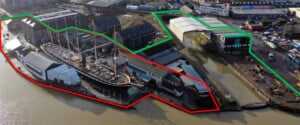
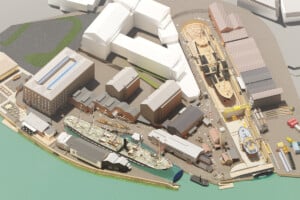
The masterplan: saving a Grade II listed dock
The Albion Dockyard, which began work in 1820, has more than 200 years of history as a shipbuilding and ship repair yard. The project will protect and enhance Bristol’s unique harbour heritage and ecology while transforming the Albion Dockyard with a world-class maritime attraction inside a thriving working shipyard. The Grade II listed dock itself will be conserved, maintaining a working dry dock and reinstating the original clock tower. A new education centre equipped with digital virtual learning tools will be located within one of the Trust’s existing buildings. It will open up learning opportunities for young people, including those with low levels of attainment.
The expanded historic dockyards will cherish and restore much of the heritage landscape. Existing structures that reflect the docks heritage will be repurposed, with a double-height former workshop becoming the heritage site’s new café and providing exhibition space. A listed wall between the Great Western Dockyard and Albion Dockyard will be saved, enhancing the heritage landscape and providing sweeping courtyards for dockyard interpretation, live demonstrations and ‘living museum’ experiences.
The dry dock itself will be sympathetically divided into two. The front portion will continue ship repairs as a working shipyard which the SS Great Britain Trust restarted back in 2018 when the dock lay derelict. The back portion of the dock will become part of the heritage experience, fittingly bringing the story of the other great Brunel Bristol-built ship to life.
Creating a world-class maritime attraction
The centrepiece for the Albion Dockyard will be a full-scale recreation of the paddle steamer ship PS Great Western, built in Bristol six years before the SS Great Britain.
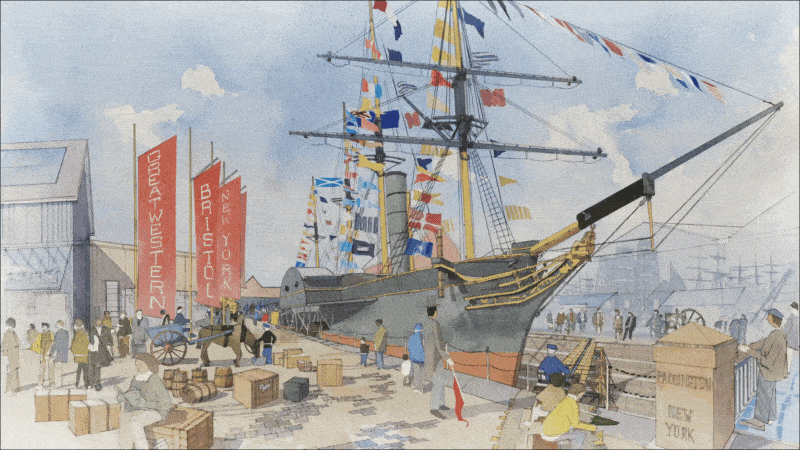
PS Great Western was the first paddle steamer built to cross the Atlantic on a regular, highly successful service. Following her first crossing in 1837 she became a celebrity on both sides of the Atlantic. She travelled between the Bristol Channel and New York for 10 years, and it is likely that she used the Albion Dock for repairs at least once. The story of PS Great Western is closely linked to the SS Great Britain, Brunel and Albion Dock.
Recreating this Bristol-built pioneer ship in the Albion Dock will add a magnificent new spectacle to the harbour’s heritage landscape. Together, the heritage dockyards, the two historic ships, and the working Albion Dockyard will have a critical mass for tourism and education, especially the STEM education needed to grow the next generation of engineers and entrepreneurs.
The new addition will create a striking visual presence evoking the city’s role in pioneering global ocean travel. This project will explore the relevance of this history to all of Bristol’s communities, especially those with experience of migration. The project aims to make exploring heritage more inclusive and accessible, especially for people who experience barriers to participation.
PS Great Western interiors will provide engaging museum experiences which will bring global passenger stories and travel to life. The ship will also provide the charitable trust with additional flexibility for corporate entertaining spaces including private dinners which might take place within the interior spaces.
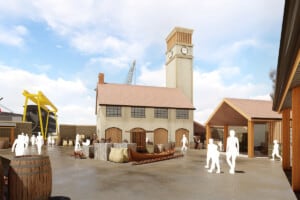
Placemaking: repurposing and recreating old buildings
This project very much focuses on conserving and repurposing buildings from various eras on the site and presenting them within a more consistent historic context. The 19th century workshop building at the centre of the site will become a café and exhibition space providing 100 covers inside for visitors to the heritage attraction and for private dining. All overlooks from the café will look onto the dock and heritage courtyard.
The Albion dockyard clock tower from the 1800s no longer survives. It will be recreated and reinstated as old photographs show it to be a striking and beautiful element of the heritage landscape. The interior will provide further exhibition space with the small tower providing views of the harbour and dock.
An existing building to the west of the Albion Dry Dock will be maintained with continued use as a workshop for conservation and maintenance. The buildings towards the harbour-end of the dock will continue to be used as part of the ship repair operation as they have been for many decades, while the dockyard and areas closer to neighbouring properties will all form part of the heritage conservation and museum experience.
Establishing a voluntary marine nature reserve
The harbour today provides space for locals and visitors alike, and the Albion Dockyard Project will establish the waterway as one of the country’s first voluntary marine nature reserves, enhancing habitats and maritime heritage.
A new reed bed will be added alongside the harbour beside the Great Western Dockyard. Partnerships with organisations including the Avon Wildlife Trust will further enhance the focus on wildlife, habitats and ecology. The SS Great Britain Trust has declared both a Climate Emergency and an Ecological Emergency, and plans for this project prioritise sustainable development and enhancing landscapes and habitats.
Restoring historic harbour vistas
The project plans are informed by expert research into the historic environment of the Albion Dockyard and the neighbouring Great Western Dockyard. The evidence of historic plans, descriptions, paintings and photographs will inform the recreation of an authentic, immersive dockyard where visitors can see, smell, hear, and interact with real history. The dockyard reconstruction will include reinstating a campanile clock tower to the heritage landscape. Roughly-built lean-tos will house workshops for demonstrations of traditional crafts which were once essential to shipbuilding in the Albion and Great Western dockyards. New living history workshops around the dockyard may include rope-working, carpentry and smithing in a purpose-built shed adjoining the working dock. Demonstrations will be a highlight for audiences during peak visitor hours. Like other heritage sites, an Albion Dock smithery would likely use smokeless fuel or other alternatives to traditional coal products.
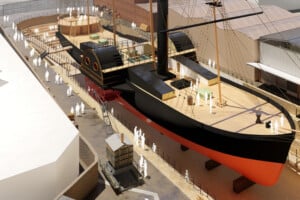
Creating unique spaces for interpretation and ’living history’
Throughout the site, visitors will see and meet costumed characters, re-enacting the activities and conversations of people who worked in the dockyard or on board the ships, or who set sail as passengers for New York, Australia, the West Indies or the Crimea.
Spaces for ‘living history’ engagement will be created naturally throughout the dockyards as courtyards between buildings facilitate visitor flow. Conservation of the Albion Dry Dock itself will include sympathetic seating designed into the dock wall at one end, providing a small acoustic amphitheatre space.
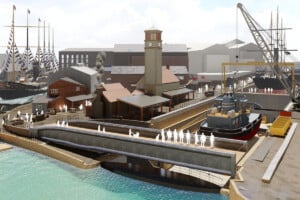
Saving Brunel’s Swivel Bridge and drag boat
This project will save Brunel’s Swivel Bridge which presently sits deteriorating at the far side of Cumberland Basin. Specialist Brunel experts and conservers will ensure that the bridge is rescued, relocated back to the Albion Dockyard where it was first constructed and becomes an iconic element of the harbourscape to be enjoyed by locals, harbour users and visitors alike.
To be located across the end of the Albion Dry Dock, the bridge will for the first time be prominently seen by locals from across the harbour as well as by harbour users and visitors to the heritage site. In returning the bridge to working order, occasional scheduled “swings” will become local spectacles best freely viewed from Hotwell Road. Additionally, there will be free public access and tours during a number of heritage and ‘Open Doors’ events as well as for the Great Bristol Half Marathon.
In its current state, the swivel bridge is fragile and needs specialist conservation for the long term. The SS Great Britain Trust has the right expertise to do this work. It was originally built for Brunel in the Albion Dockyard, so its history is strongly linked to this site.
This project will also conserve Bertha – a Brunel-designed drag boat (a steam-powered dredger that ran on chains). The drag boat will be displayed publicly for the first time in the setting of the Albion Dockyard, telling an important story of the development of local harbours like Bristol and Bridgwater where she operated for many decades.
Growing the economy and investing in Bristol
Expansion of the tourism draw is projected to bring at least £8.1 million additional spend into the West of England economy every year, and to provide 189 new jobs. The learning programmes, ecological improvements and conservation will provide significant further benefits for the region. And the project will deliver benefits for communities, consulting and developing elements with them as well as collaborating with key partners including Avon Wildlife Trust, Black South West Network, City of Bristol College and the Restore Trust.
The Albion Dockyard Project has the support of Bristol City Council and West of England Combined Authority, and is set to benefit every area of the region – Bristol, South Gloucestershire, Bath and North East Somerset, and North Somerset – as it shines the spotlight on Brunel heritage and expands STEM learning in every area of ‘Brunel Country’.
Providing sustainable accessibility for more visitors
With part of this project making the Albion Dockyard accessible as an expanded heritage attraction for visitors and community engagement, higher footfall will be comfortably accommodated within traditional daytime opening hours. With easy access on foot alongside the harbour itself, and by bicycle and Metrobus, the Trust will encourage sustainable transportation choices. Car parking will not be expanded however the Park and Ride option will become a preferred promoted option utilising the Metrobus route , which is proposed to stop closer to the heritage site.
The Trust’s emphasis on sustainable transport includes provision for bicycles and scooters as well as continuing to work in partnership with Bristol Ferries, the Cross Harbour Ferry, Bristol City Council, West of England Combined Authority and supporting transportation providers where possible.
FAQs – answering questions about the project


